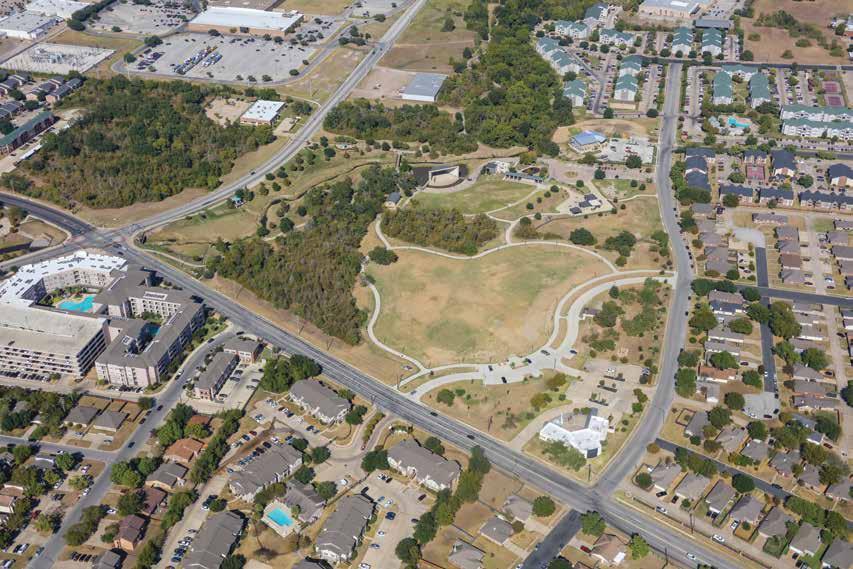

REZONING GUIDEBOOK
• The Fundamentals of Zoning
• Steps to Applying for a Rezoning
• Additional City Resources
This sheet is not for Planned Development Districts.
FUNDAMENTALS OF ZONING

In a municipality, all land is categorized through zoning districts. A district represents a package of specific regulations regarding the use of the land in that zone. Further information about each district’s regulations can Unified Development Ordinance (UDO), and a complete table of the uses allowed in each district 6.3 “Types of Use” in the UDO.
To change the allowed uses and associated regulations on a specific property, the property has to be rezoned. Requested rezoning of a property must be consistent Comprehensive Plan’s Future Land Use & which is intended to preserve the quality of life and orderly development of the City.
WHAT IS FUTURE LAND USE?
Future land use (FLU) guides how all property within the . All land in the City has a future land use designation, as shown on the Comprehensive Plan's Future Land Use & Character Map (commonly called Each future land use category has a character-based description and overall intent, along with generally appropriate zoning districts to choose from that help achieve the desired character. These categories are described in the Comprehensive Plan.
• WHAT IS THE DIFFERENCE BETWEEN ZONING AND FUTURE LAND USE?
Future land use guides zoning, but is not zoning itself. A single future land use category can prescribe multiple zoning districts to choose from, but a property can only be zoned for one district at any given time. Zoning regulates how a property can be developed and used today, while future land use describes what the property’s zoning could change to in the future.
• WHY WOULD AN OWNER WANT TO REZONE THEIR PROPERTY?
If the current or intended use of the land does not align with the regulations of the property's zoning district, a landowner may explore rezoning their property to a district with a more compatible set of regulations. The alternative zoning district must be compatible with the Comprehensive Plan’s Future Land Use Map.
• WHAT IF THE PROPERTY OWNER WANTS TO APPLY FOR A REZONING TO A DISTRICT NOT PRESCRIBED BY THE FUTURE LAND USE MAP?
A Comprehensive Plan Amendment (CPA) changing the future land use designation to one which allows the alternative zoning district would first be necessary. While CPAs and rezoning applications can be processed in tandem, the CPA process must be initiated first since the viability of a potential rezoning would be contingent on its approval.
• For more information on Comprehensive Plan Amendments, please refer to the CPA guidebook.
REZONING A PROPERTY
The desired zoning district is incompatible with the Comprehensive Plan. A rezoning that complies with the current land use category may be pursued.

Future Land Use Category
Urban Center
Neighborhood Center
Generally Appropriate Zoning Districts
• Mixed-use, Northgate zoning (in Northgate only), Wolf Pen Creek zoning (in Wolf Pen Creek only)
• Mixed-use, Wolf Pen Creek zoning (in Wolf Pen Creek only), commercial and multi-family zoning may be considered in some circumstances if designed in an integrated manner through a Planned Development District with a preferred emphasis on urban form.
General Commercial
Neighborhood Commercial
Business Center
Urban Residential
Mixed Residential
Suburban Residential
Estate Residential
Neighborhood Conservation
Texas A&M University
Institutional/Public
Medical
Parks & Greenways
Rural
• General commercial, o ce, and mixed-use zoning
• Suburban commercial and o ce zoning. Within the Wellborn District, limited to Wellborn Commercial zoning.
• Business park, industrial, and commercial industrial zoning
• Multi-family, townhouse, mixed-use, and limited suburban commercial zoning
• Duplex, townhouse, middle housing, and limited-scale single-family
• General and restricted suburban zoning. Within the Wellborn District, limited to Wellborn Restricted Suburban zoning.
• Estate, rural, and manufactured home park zoning. Within the Wellborn District, limited to Wellborn Estate zoning.
• General and restricted suburban, single-family overlays
• Areas owned by Texas A&M University and are appropriate for campus development as described in the Texas A&M Campus Master Plan and related documents.
• Areas that are, and are likely to remain, in some form of institutional or public activity.
• Varies
• Natural areas protected
• Rural and manufactured home park
STEPS TO APPLY FOR A REZONING
1. Preliminary Research:
Check the property's future land use and determine if a CPA is necessary
Check the rezoning review criteria in the UDO
Reach out to City Sta to discuss the procedures, standards or regulations relating to the project, either by contacting the Planner-on-Call or scheduling a pre-application conference
2. Create an account to utilize the City's online permitting system, eTRAKiT by contacting 979-764-3570 or cspds@cstx.gov
3. Submit a rezoning application for Sta to review
4. Public Hearings Planning & Zoning Commission City Council
PRELIMINARY RESEARCH CREATE ACCOUNT
APPLICATION SUBMITTAL
STAFF REVIEW
PUBLIC HEARINGS


CITY RESOURCES
Comprehensive Plan
Planning & Development Services
Unified Development Ordinance
Planning & Development GIS Map
Development Regulations
City of College Station
